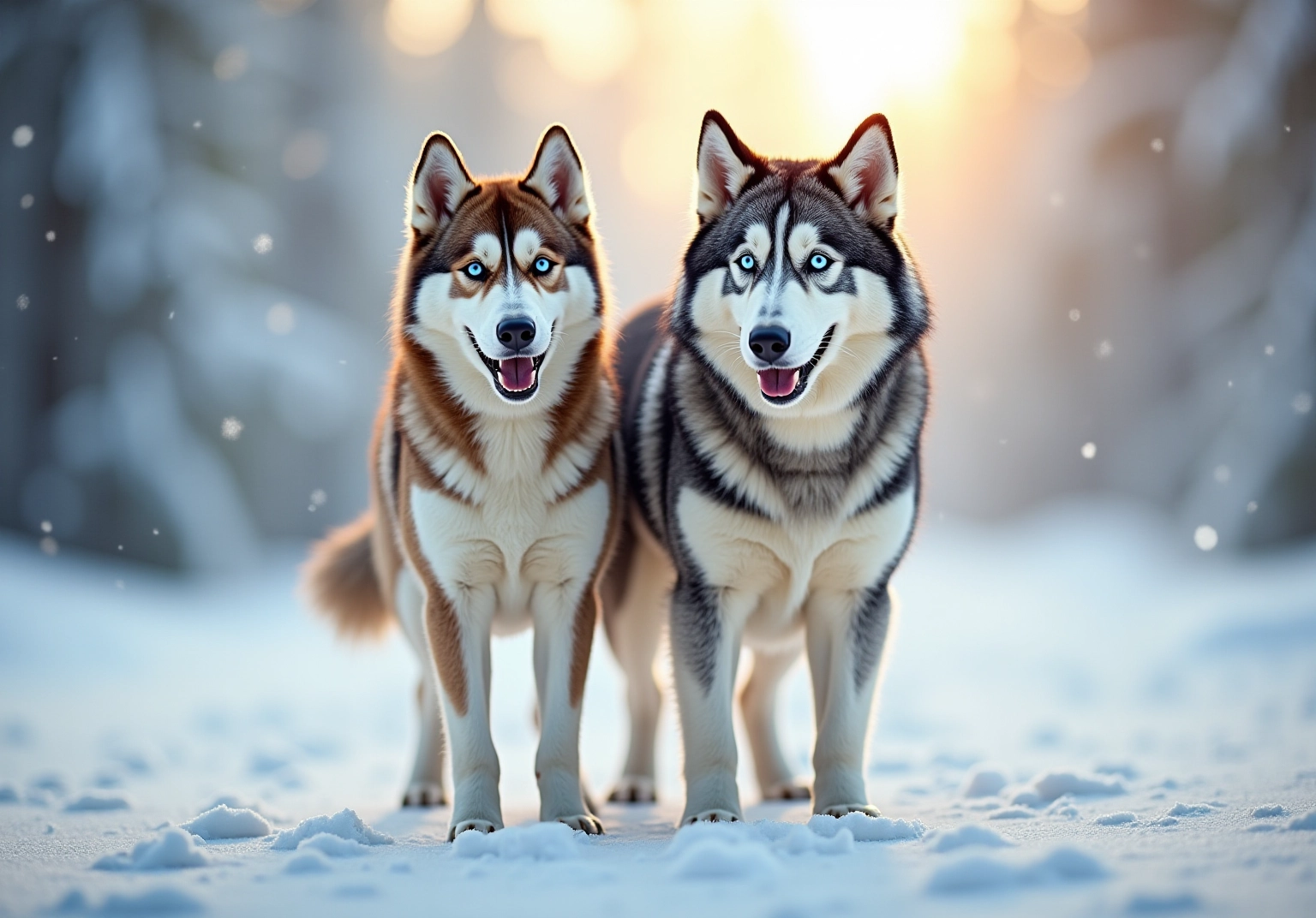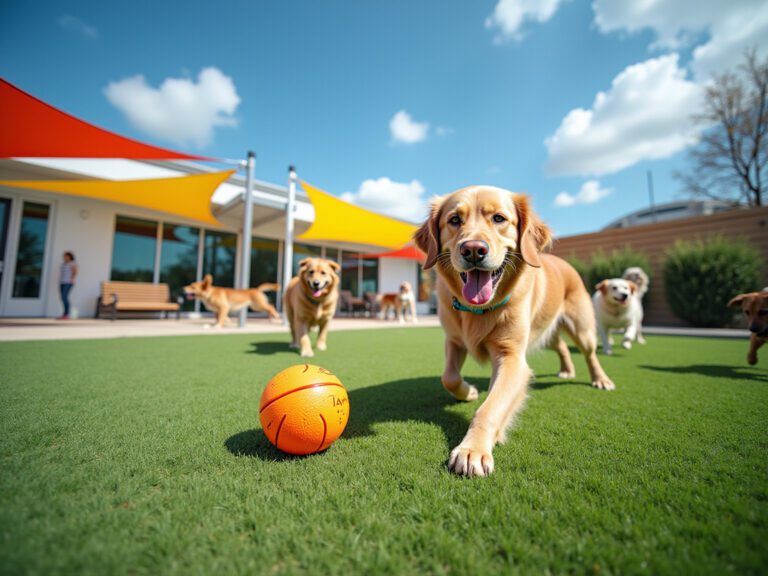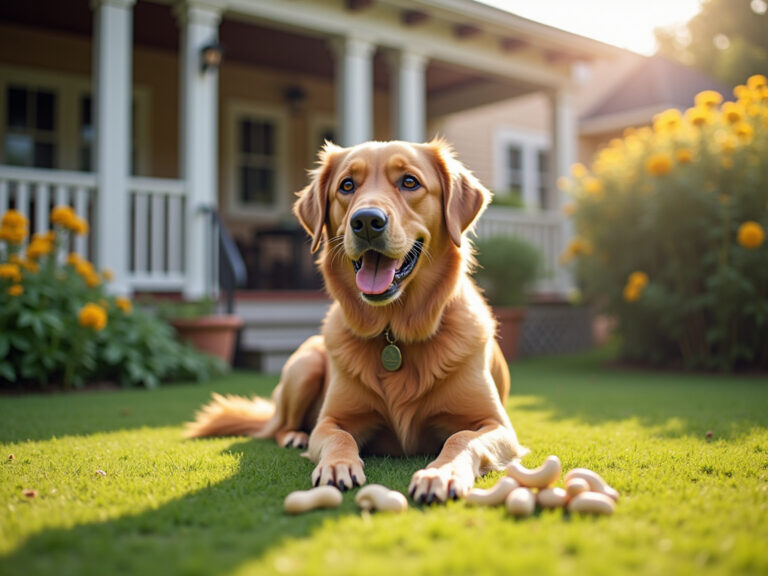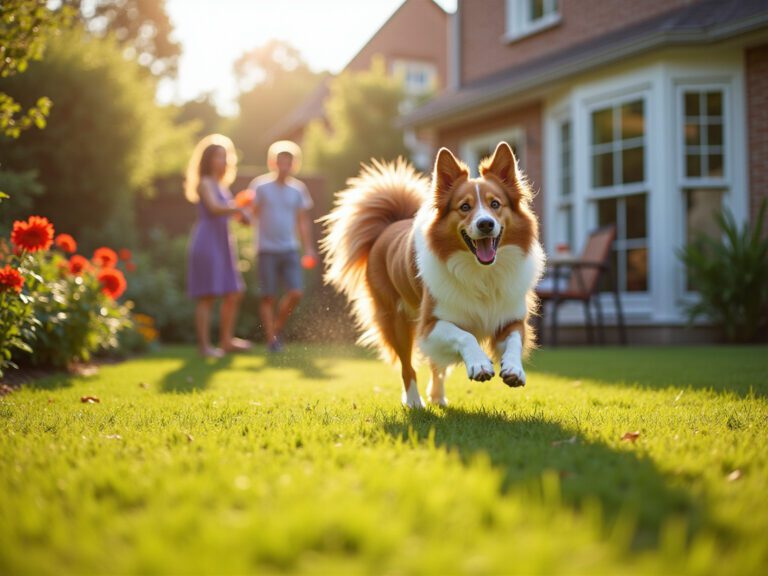Husky vs Malamute: Key Differences Every Family Should Know
Overview
Understanding the key differences between the Siberian Husky and Alaskan Malamute can help you choose the right companion for your family. These breeds vary in size, temperament, and historical roles, which can influence their fit within your nurturing environment.
- Huskies, known for their agility and sociability, tend to thrive in active households where they can engage with family members.
- In contrast, Malamutes are larger and more independent, requiring structured training and socialization. They are perfect for families seeking a loyal yet laid-back furry family member.
By recognizing these traits, you can make a choice that aligns with your lifestyle and emotional needs, ensuring a harmonious relationship with your pet.
Introduction
The debate between the Siberian Husky and the Alaskan Malamute often captivates dog enthusiasts and potential owners alike. Both breeds boast a rich history rooted in the Arctic and share a striking resemblance that can easily confuse the untrained eye. While the Husky is renowned for its agility and speed, making it a favorite for those seeking an energetic companion, the Malamute’s impressive strength and endurance cater to families looking for a loyal, heavy-duty worker.
However, beneath their similar exteriors lies a world of differences in temperament, exercise needs, and health considerations. These factors can significantly impact a family’s decision. Which breed truly aligns with your family’s lifestyle and expectations? Understanding these nuances is crucial for making an informed choice that will lead to a harmonious home for your furry family members.
Overview of the Siberian Husky and Alaskan Malamute
The husky vs malamute discussion highlights how both breeds are sturdy with rich histories in the Arctic, each playing a unique role in the world of sledding. The Siberian Husky, celebrated for its agility and speed, was lovingly bred by the Chukchi people to pull sleds across vast distances, showcasing its remarkable quickness and endurance. In contrast, the Malamute was developed by the Mahlemiut tribe for heavy hauling, highlighting its incredible strength and ability to carry substantial loads.
While both the husky vs malamute share a striking appearance characterized by their thick fur and wolf-like features, their historical functions reveal key differences in temperament and physicality. For instance, Huskies typically weigh between 40 to 60 pounds and enjoy a lifespan of 12 to 15 years. Malamutes, on the other hand, are larger, usually ranging from 75 to 85 pounds, with exceptionally large males potentially reaching 100 pounds, and they have a lifespan of 10 to 14 years.
Understanding these differences, along with common health concerns like day blindness and cataracts in Alaskan Malamutes, is vital for prospective owners. This knowledge ensures that you can make informed decisions about your furry family members’ suitability with your family lifestyle and exercise needs. Moreover, the Husky was ranked as the 12th most popular breed by the American Kennel Club in 2017, reflecting its appeal among dog lovers. Embracing this information can help you provide a nurturing environment for your beloved pets.
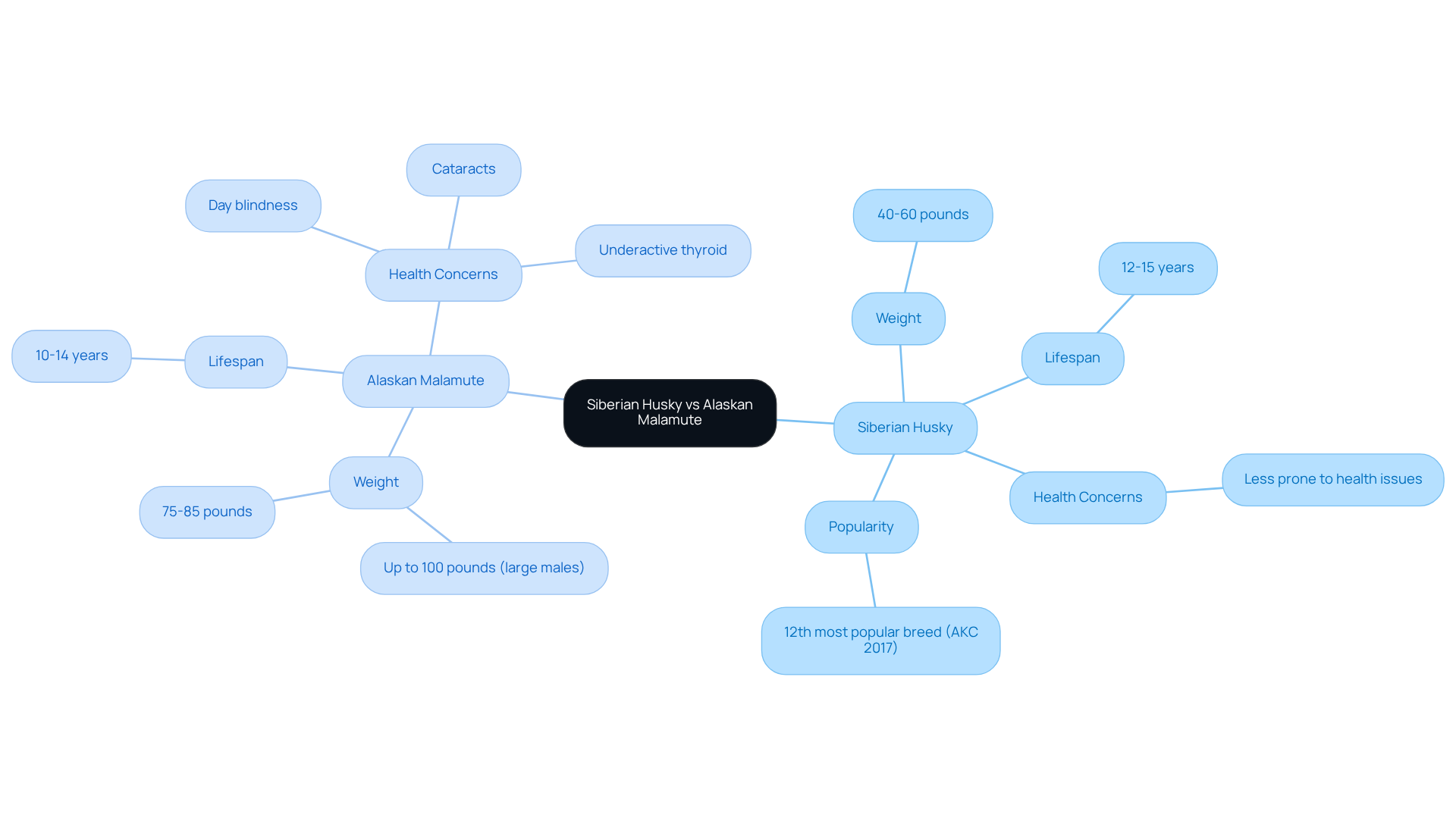
Historical Background and Origins
The roots of the Husky can be traced back over 4,000 years to the Chukchi people of the region, who lovingly bred these dogs for companionship and as sled dogs. Their remarkable ability to work in packs and endure extreme cold made them essential for survival in harsh Arctic conditions. In fact, the Chukchi people relied on these loyal companions not only for transportation but also for warmth during cold nights, as the phrase ‘three dog night’ suggests.
In contrast, the Malamute’s lineage is connected to the Mahlemiut tribe, who depended on these strong dogs for heavy freight transportation and hunting. This historical role has contributed to the Malamute’s robust build and strong work ethic, highlighting the differences in traits when comparing husky vs malamute, particularly in agility and speed. As Lenore Demmin, president of the Siberian Husky Club of America, aptly compares, ‘The Siberian Husky was bred to pull light loads over long distances. The Alaskan Malamute was bred to pull heavy loads over short distances.’
While both the husky vs malamute share a common ancestry, their distinct purposes have influenced their physical traits and temperaments, making them uniquely suited to various tasks and lifestyles. Additionally, both breeds are generally healthy but can suffer from health issues like hip dysplasia, which is an important consideration for potential owners when choosing between them. Understanding the differences in characteristics between husky vs malamute can help you find the perfect furry family member that fits your lifestyle and needs.
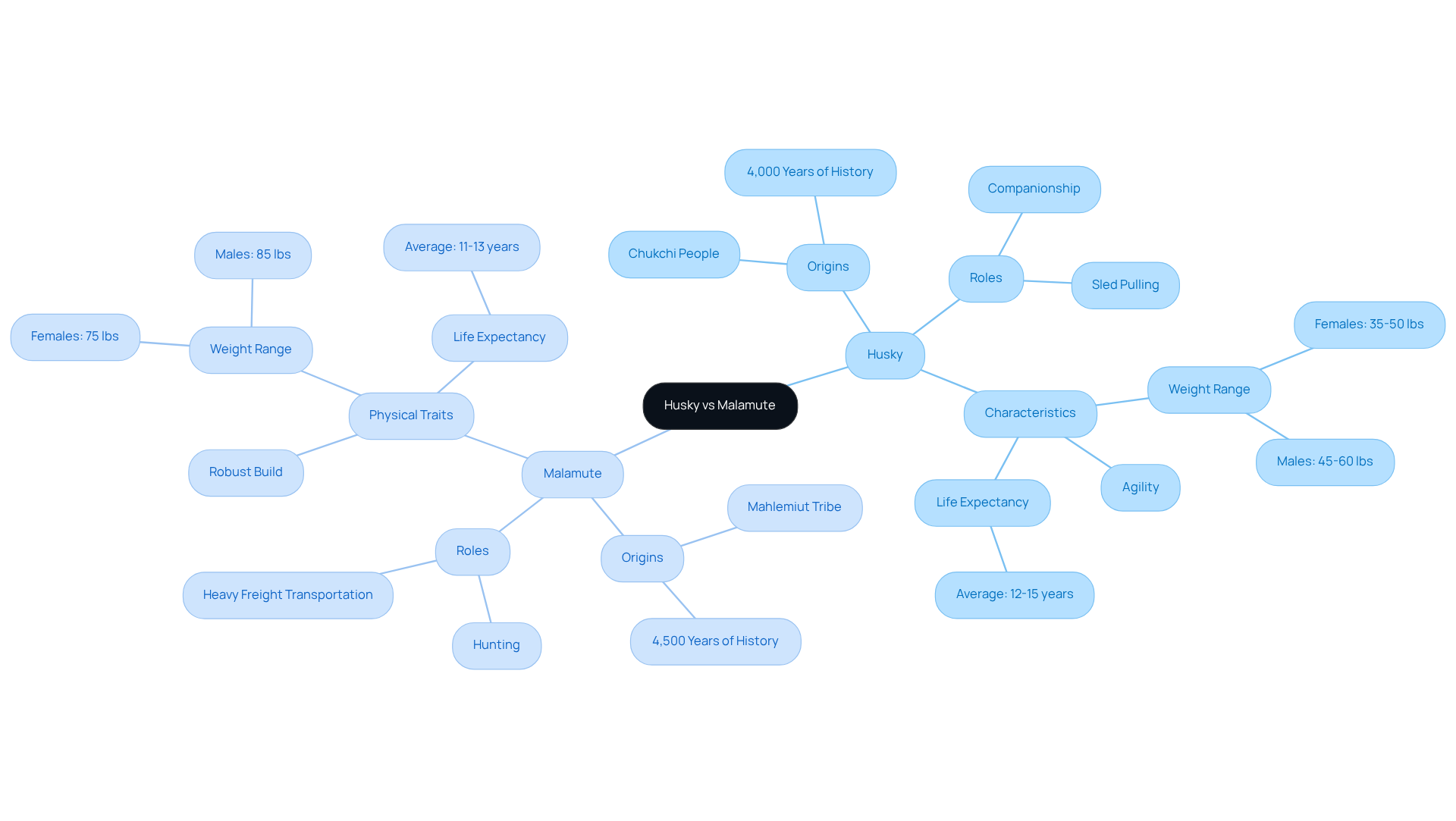
Physical Characteristics: Size, Coat, and Features
When considering a furry family member, understanding the unique traits of breeds such as the husky vs malamute is essential. The Siberian Husky typically weighs between 35 and 60 pounds and stands about 20 to 24 inches tall, showcasing a lean and athletic build. Their double-layered coat offers insulation against cold weather, requiring weekly brushings due to frequent shedding. Many find joy in their striking blue or multi-colored eyes, which add to their charm.
In contrast, the Alaskan Malamute is significantly larger, weighing between 75 and 100 pounds and standing 23 to 25 inches tall. This breed features a thick, coarse coat designed for heavy-duty work in extreme conditions, complemented by a broad head and a plumed tail that curls over its back. These physical differences highlight their distinct functions in sledding and transporting. In the debate of husky vs malamute, the Husky excels in speed and endurance, while Malamutes are designed for strength and heavy lifting.
Both breeds require at least 2 hours of exercise each day, making them ideal companions for energetic families. It’s important to be aware of health considerations, as both breeds can be predisposed to conditions like hip dysplasia and juvenile cataracts. Routine veterinary care is crucial for maintaining their health and well-being.
Historically, sled dogs played a vital role in the 1925 serum run to Nome, showcasing their remarkable endurance and strength. Understanding these traits not only helps in choosing the right breed but also in providing a nurturing environment where your beloved pets can thrive.
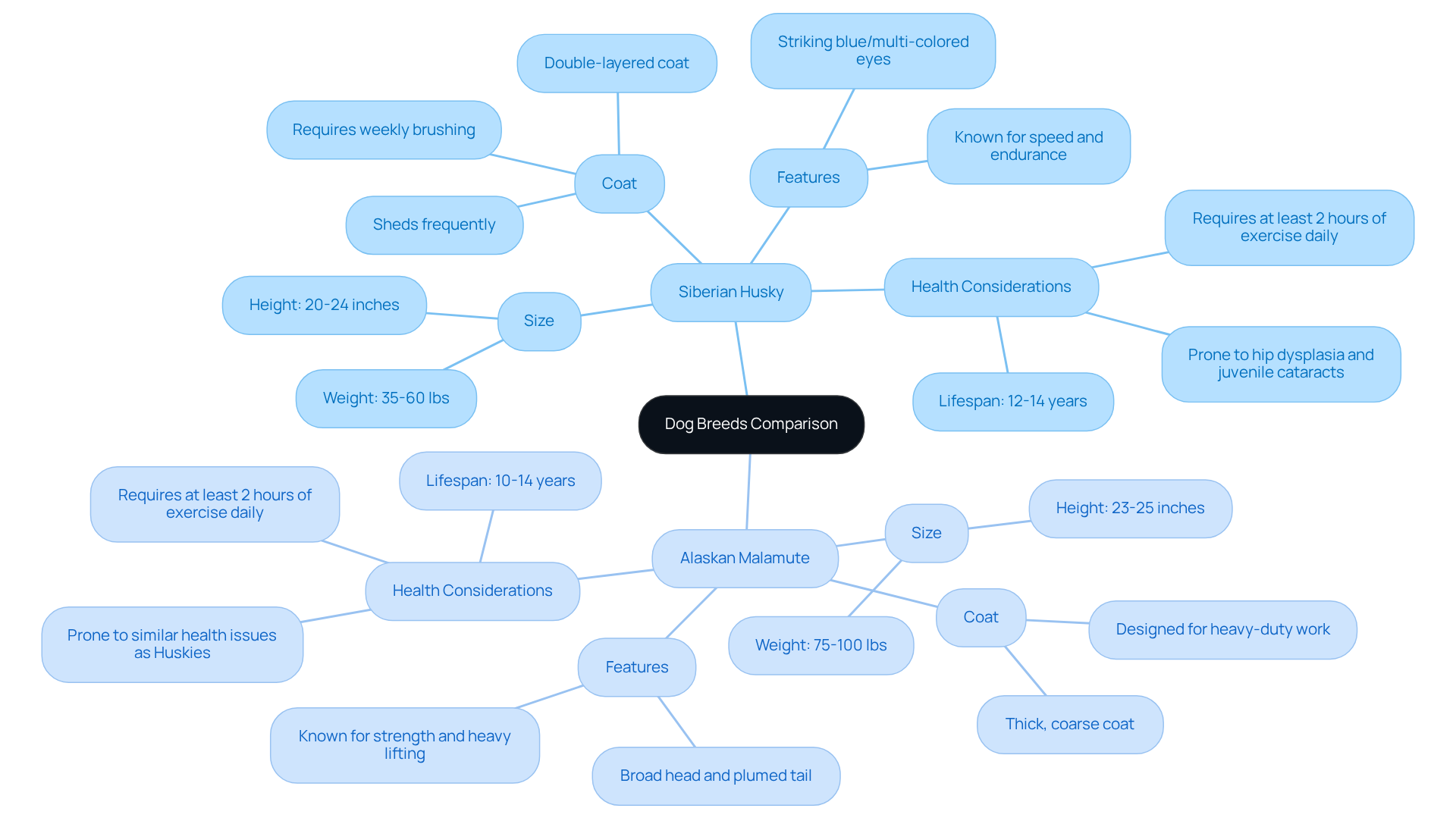
Temperament and Behavior: Understanding Each Breed’s Personality
Siberian Huskies are truly celebrated for their friendly and outgoing nature, often characterized as playful and mischievous. These delightful dogs thrive on social interaction and are known for their vocalizations, which can include howling and barking. To direct their abundant energy constructively, they require a minimum of 1-2 hours of vigorous exercise each day. In contrast, Alaskan Malamutes exhibit a more reserved and independent demeanor. While they form strong bonds with their families, they can be a bit aloof with strangers. Their loyalty often translates into a protective instinct, making them excellent companions for families who cherish a devoted pet.
Behavior training for both breeds can vary significantly due to their distinct temperaments. For example, these dogs truly benefit from positive reinforcement methods that reward desired behaviors, as they respond well to engaging and interactive training sessions. Annette Louviere, DVM, emphasizes that to be happy, Siberian dogs require plenty of attention and physical exercise. On the other hand, Malamutes may need a more structured approach, as their independent nature can make them less eager to please. Statistics show that early socialization is essential for both types; Huskies, in particular, require exposure to different environments and individuals to foster good behavior, while Malamutes flourish in situations where they feel safe and appreciated.
Expert opinions indicate that understanding each type’s unique personality traits is essential for successful training and companionship. For instance, a well-trained Malamute can be a gentle giant, known for its affectionate nature towards children, while a well-exercised Husky can be a calm and loving family member. Additionally, potential health issues such as hip dysplasia and eye problems are important considerations for Husky owners. Ultimately, both types provide unique benefits and challenges, making it essential for prospective owners to consider their lifestyle and preferences when selecting between them.
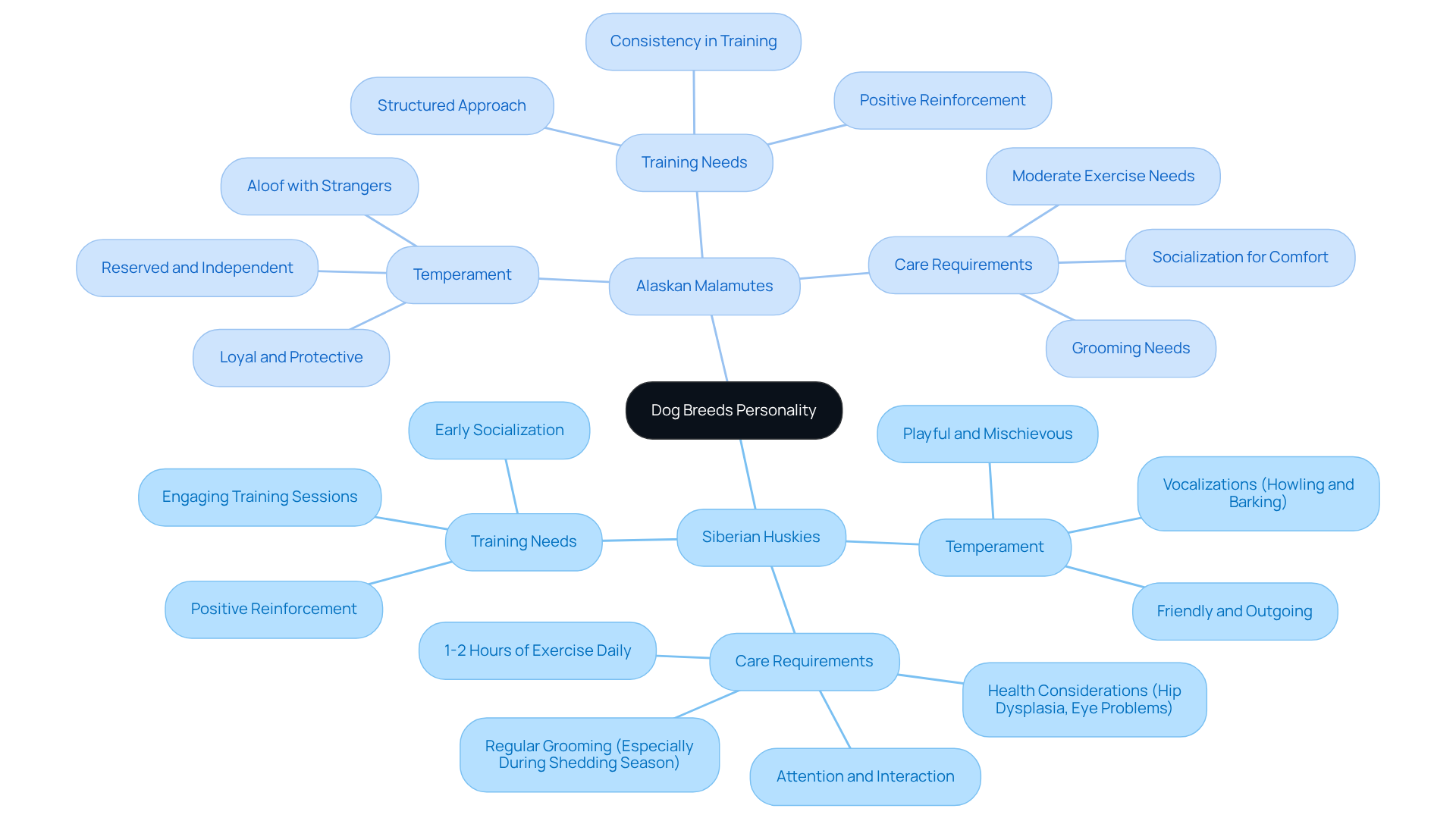
Exercise and Training Requirements: Meeting Their Needs
When considering husky vs malamute, it’s important to note that Siberian Huskies, your energetic furry family members, require at least 1-2 hours of vigorous exercise each day. They thrive on activities like running and playing, showcasing their high energy levels and need for mental engagement. This makes them one of the breeds with the highest exercise demands. Similarly, in the husky vs malamute comparison, Alaskan Malamutes also need substantial exercise, typically around 1-2 hours, but their focus leans more towards strength-based activities like pulling and hiking.
Both breeds benefit from regular training, though the northern dog variety may require a bit more patience due to their independent and obstinate nature, which can make training a challenge. In contrast, Malamutes respond well to firm, consistent leadership. It’s essential for owners to establish clear boundaries and expectations to nurture a strong bond.
As Caitlin Ryan, founder of Malamute Mom, wisely notes, when comparing husky vs malamute, both breeds can be incredibly rewarding and loyal companions when their needs are met. Their friendly and outgoing temperament adds to their charm, making them delightful additions to any family. To effectively meet their mental and physical needs, consider incorporating varied exercise routines and engaging puzzle toys into their daily activities, ensuring a nurturing environment that fosters happiness and health.
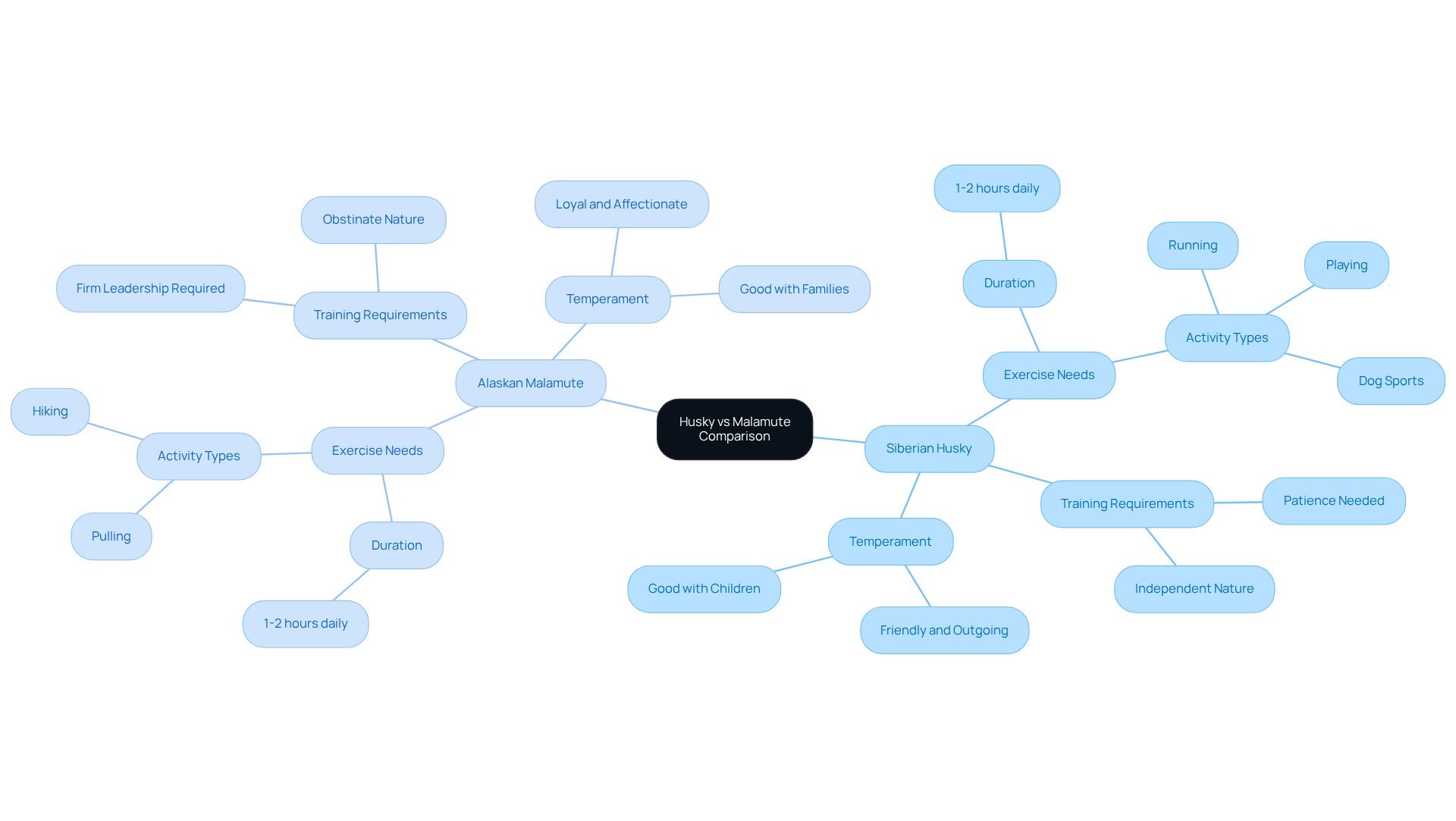
Health Considerations: Common Issues and Lifespan
Siberian Huskies, your furry family members, typically enjoy a lifespan of 12-15 years, which can be an interesting point of discussion in the husky vs malamute comparison. However, they can face health challenges such as:
- Hip dysplasia
- Cataracts
- Progressive retinal atrophy
In the discussion of husky vs malamute, the Alaskan Malamute, another beloved breed, has a slightly shorter lifespan of 10-14 years and may encounter health concerns like:
- Hip dysplasia
- Hypothyroidism
- Sensitive skin
- Lameness
- Digestive issues
- Arthritis
- Gastric torsion
To ensure a long, healthy life for these wonderful companions, routine veterinary examinations and a nutritious diet are essential. For Alaskan Malamutes, a protein-dense diet is particularly important to support their large bodies and active lifestyles. By prioritizing their health, you can help your pets thrive.
Maintaining a healthy weight and ensuring adequate exercise are crucial. Additionally, following specific care practices—such as dental care, ear cleaning, and nail trimming—can significantly enhance their quality of life. Being aware of common health concerns empowers you to seek appropriate veterinary care, ensuring your pets lead healthy, fulfilling lives.
At Adventure Den, we understand the deep bond you share with your pets. By fostering a nurturing environment, we can help you navigate their health needs with compassion and expertise. Together, let’s ensure that your furry friends enjoy the best life possible.

Suitability for Families: Which Breed Fits Your Lifestyle?
Families with active lifestyles often find the Siberian Husky to be an ideal companion due to their playful and energetic disposition. These dogs are generally sociable, exhibiting a friendly nature towards children and other pets, making them well-suited for multi-pet households. In fact, studies indicate that Huskies rank highly in family compatibility, showcasing their adaptability in dynamic environments.
Conversely, Alaskan Malamutes cater to families seeking a more laid-back yet loyal companion. While they are affectionate and protective, they require dedicated training and socialization, particularly around children. Expert insights suggest that Malamutes thrive in environments where they receive consistent guidance and interaction.
Ultimately, the choice between husky vs malamute should reflect your family’s activity level, experience with dogs, and preference for a more social or independent pet. Understanding these nuances can significantly enhance the harmony within your household, ensuring a fulfilling relationship with your furry family members.
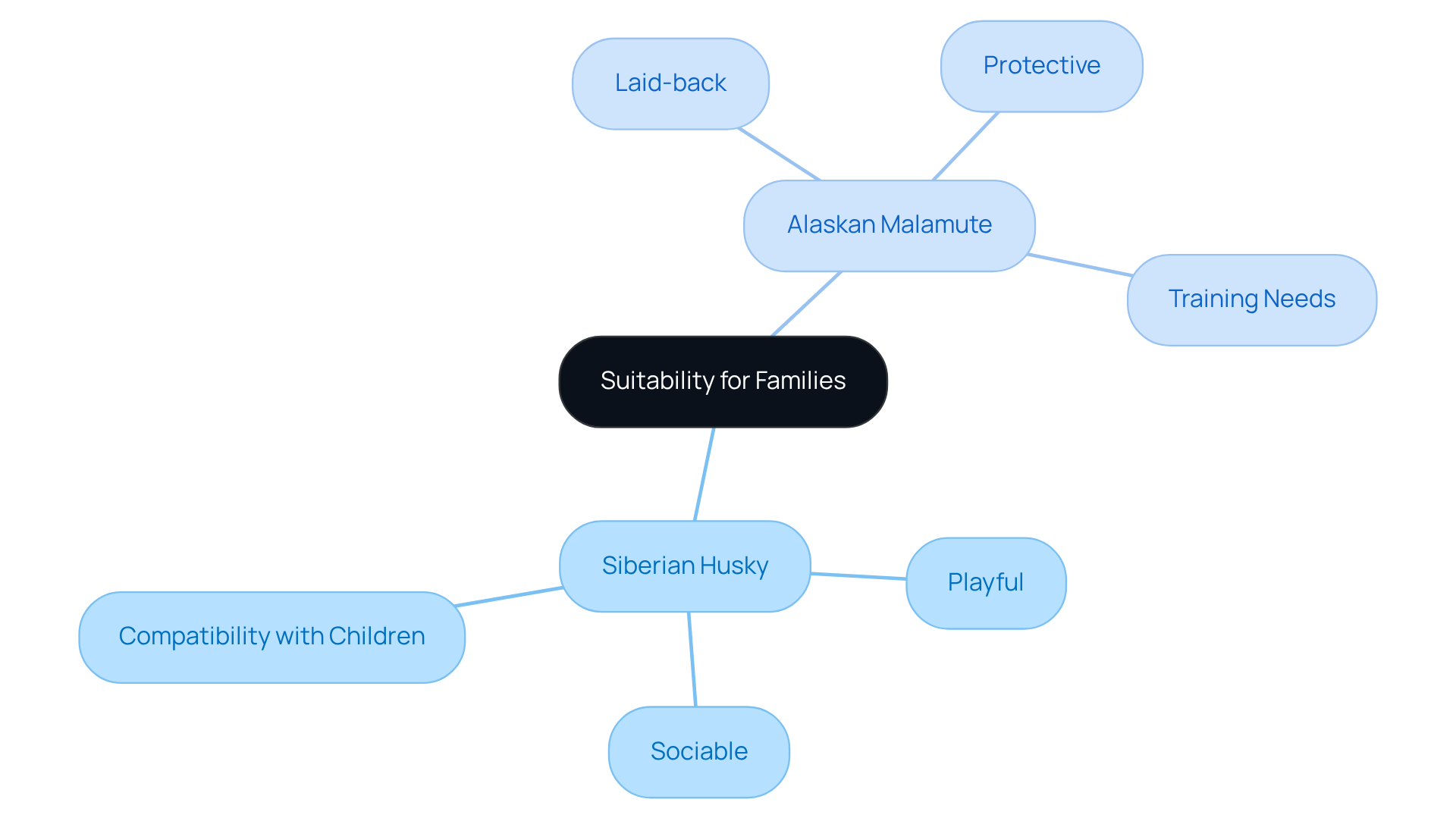
Conclusion
Both the Siberian Husky and Alaskan Malamute are remarkable breeds, each with unique characteristics that cater to different lifestyles and preferences. Understanding the distinctions between these two breeds is crucial for potential pet owners, as it allows for a more informed decision when choosing a furry family member. Each breed has its own strengths and challenges, which can significantly impact family dynamics and individual experiences.
Key points of comparison include:
- Size
- Physical traits
- Exercise needs
- Temperament
Huskies are known for their agility and sociable nature, making them ideal for active families. On the other hand, Malamutes exhibit strength and loyalty, appealing to those who appreciate a more independent companion. Both breeds require substantial exercise and training, yet their personalities dictate different approaches to these needs. Awareness of common health concerns also plays a vital role in ensuring a long and healthy life for either breed.
Ultimately, the choice between a Husky and a Malamute should align with your family’s lifestyle, activity level, and preferences for companionship. By carefully considering these factors, prospective owners can foster a nurturing environment that supports the well-being of their chosen breed. Embracing the unique qualities of each dog will enrich family life and create lasting bonds with these incredible animals.
Frequently Asked Questions
What are the main differences between Siberian Huskies and Alaskan Malamutes?
Siberian Huskies are known for their agility and speed, typically weighing between 40 to 60 pounds, while Alaskan Malamutes are larger, weighing between 75 to 85 pounds, with some males reaching up to 100 pounds. Huskies have a lifespan of 12 to 15 years, whereas Malamutes live around 10 to 14 years.
What historical roles did Huskies and Malamutes play?
Siberian Huskies were bred by the Chukchi people for companionship and as sled dogs, enabling them to pull sleds across long distances. Alaskan Malamutes were developed by the Mahlemiut tribe for heavy hauling and hunting, showcasing their strength and work ethic.
How do the temperaments of Huskies and Malamutes differ?
The temperament of Huskies is generally more energetic and agile, suited for pulling light loads over long distances. In contrast, Malamutes are strong and robust, designed for pulling heavy loads over shorter distances.
What are some common health concerns for these breeds?
Both breeds are generally healthy but can experience health issues such as hip dysplasia. Alaskan Malamutes may also face specific concerns like day blindness and cataracts.
How popular are Siberian Huskies as pets?
The Siberian Husky was ranked as the 12th most popular breed by the American Kennel Club in 2017, indicating its appeal among dog lovers.
What should prospective owners consider when choosing between a Husky and a Malamute?
Prospective owners should consider the differences in size, lifespan, temperament, exercise needs, and potential health concerns to determine which breed best fits their lifestyle and family environment.

